Pangolin’s Trade, Importance and It’s Conservation Status
- Nature Khabar
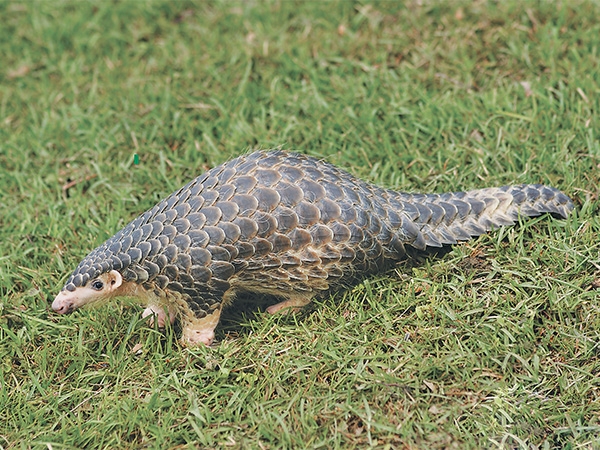

1.INTRODUCTION
1.1 Background
Two species of pangolins are found in Nepal: Chinese pangolin (Manispentadactyla) and Indian pangolin (Maniscrassicaudata) (Baral and Shah, 2008; Jnawali et al., 2011). They are .small in size and weight having well developed external ear (Suwal, 2011) with a streamline elongated body with a long tail. Chinese pangolin are 70-80 cm long with tail 28-34cm and are covered with large rounded overlap scales of dark brown and yellow brown colour (Heath, 1992) whereas the Indian Pangolin are 100-120 cm with yellowish brown scales on the body (Chakraborty et al., 2002). Pangolins are widely distributed in primary and secondary tropical forests, limestone forests, bamboo forests, grasslands and agricultural fields (Gurung, 1996; Suwal, 2011) which digs its own burrows, or enlarges passages made by termites. Pangolins are solitary, nocturnal, good climber though terrestrial (Kaspal, 2009). The diet consists of ants and termites (Prater, 1971; Heath and Vanderlip, 1988). They are slow breeders (Shrestha, 2003) and generally unsocial (Suwal, 2011).
The Chinese pangolins occur in the Himalayan foothills in eastern Nepal, Bhutan and India, Bangladesh, Myanmar, Viet Nam, Thailand, China and Taiwan (Duckworth et all, 2008); whereas Indian Pangolin occurs in Pakistan ,India, China, Bangladesh, and Nepal (Molur, 2008). In Nepal, the species are found in central Nepal and eastern Nepal (Baral and Shah, 2008).
The both species of pangolin are listed on CITES Appendix II (CITES, 2000) Recent CITES Appendix I (2015) Global conservation status of Chinese pangolin is endangered (Duckworth et al., 2008) whereas Indian pangolin is near threatened (Molur, 2008). Both species are protected in Nepal by Department of National Park and Wildlife Conservation Act 1973, so the hunting of the species is prohibited in Nepal. National conservation status of Indian pangolin has been assessed as Endangered B1ab (iii, v) whereas for the Chinese pangolin it’s Endangered A2d+3d+4d (Jnawali et al., 2011). Still, the population of pangolin is decreasing sharply (Duckworth et al., 2008). The species trade levels are significant across its range, although precise estimates are unknown (CITES, 2000). Threats to pangolins include rapid loss and deterioration of available habitat and hunting for local use and for international trade in skins, scales, and meat (Duckworth et al., 2008; Molur, 2008).
1.2 Pangolin trade
Pangolin trade is one of the major trades in mammals. Pangolin trafficking is soaring due to two reasons. The first is demand in restaurants for wild meat makes up a heavy percentage. According to a survey carried out in China, in 2003, by the Wildlife Conservation Association, 2.81% of city residents interviewed often consume wildlife, 52.5% of them out of curiosity, 36.7% for nutrition, 22.4% for showing off, fashion and enjoyment. The second reason is for traditional Chinese medicine. According to the Chinese traditional medicinal culture, the scales of Pangolin are claimed to adjust internal secretion and treat gout. Scales are sold at a price of USD 65 per kg out of China, and in China USD 160 per kg, similarly in some cities such as Hebei and Anhui Sichuan, the price can reach up to USD 250 (Geng, 2009). Therefore, pangolins trade has been accelerating from bordering countries of China such as countries of South Asia and South-East Asia. Project pangolin revealed that more than 100000 pangolins were killed in world with in less than 3 years from 2011 to April 2013 (www. pangolins.org).
In Nepal, there has been numerous pangolin trade news covered up by media since last two years. Some of the filed pangolins trafficking news in national daily newspapers were:
- Man held with Pangolin scale: Police had arrested Mr. BaburamThokar (60yr) at Sarlai with 3 kg scales of pangolins in 2013 (The Himalayantimes.com-2013-02-27)
- Foreign currency, pangolin part seized: Doma Sherpa (25yr) was arrested with 9 kg of pangolins scale from Sindupalchowk (The Himalayantimes.com-2013-05-6)
- Women held with Pangolin scale: Ms Shanti Lama Tamang (53yr) was arrested from Naikap, Kathmandu with 1.8 kg of pangolins scale in 2013 (The Himalayantimes.com-2013-01-28)
- Tibet-bound illegal currencies, pangolin scales seized: Doma Sherpa (25yr), SangeTamang (16yr), Maya Sherpa (30yr), ChitraBahadur Shrestha (25yr) and Pemba Sherpa (27yr) were arrested with nine kg of pangolin scales and with large amount of foreign currency at Tatopani (MyRepublica.com-2013-05-06)
- Two nabbed with live Pangolin: BuddhimanMoktan (30yr) and Aryan Moktan (17yr) of Ramechhap were arrested with a live pangolins weighing about 12 kg, who was ready to sold at Rs 100000 at Kathmandu (The Himalayantimes.com-2012-10-28)
- Duo nabbed with 7 kg of pangolin scale: DhanBahadurGhalan (32yr) and WaisielYonjan (36yr) of Makawanpur were arrested with seven kg of pangoins from Kathamndu (The Himalayantimes.com-2012-01-19)
- Pangolin seized, three arrested: Jaman Singh Lama (46yr) of Makwanpur and Raju Lama (35yr) and Kanchha Lama of Nuwakot were arrested with a live pangolin in Kathandu in 2011 (The Himalayantimes.com-2011-07-26)
- Cops seize Chinse Pangolin sold in Kavre: Chinse pangolins was seized before exporting to foreign country. However, smugglers escaped from the area in 2011 (The Himalayantimes.com-2011-01-04)
- Smuggling of pangolin body parts unabated: Dinesh Roka (25yr) of Barabese was arrested by police with 50 kg of scales in 2012 (MyRepublica.com-2012-06-27)
- Bid to smuggle Chinese pangolin foiled: Police foiled a smuggling bid of a highly endangered animal species, rescued a Chinese Pangolin (ekantipur.com-2011-01-04)
- Pangolin smugglings on rise: A police rescued a pangolins form Kavre ready to sold to foreign country (ekantipur.com-2011-01-16)
- Pangolin smugglings on rise: Police discussed the trade of pangolins from Sankhuwasaba and Terathum (ekantiour.com-2011-11-12)
- Police team finds pangolins: Police found pangolins during its patrolling in Kavre (ekantipur.com-2012-06-20)
1.3 Justification of the study
Pangolin has received least little scientific attention in Nepal (Kaspal, 2009). The regional decline of most of species has occurred largely within the last 50 years, because of hunting for subsistence has been increasingly outweighed by hunting for the market due to weak law enforcement (Corlett, 2007). Since these species are rarely observed due to their secretive, solitary, and nocturnal habits, there is not enough research on population densities or global population (CITES, 2000). There have been few documented records, and therefore there is very little information available on the population status. It can be further justified by survey of Gurung (1996), in the Royal Nagarjun Forest in Kathmandu, from where healthy population dramatically declined due to increase access to hunting and habitat loss. The 3 current threats due to habitat destruction and trade in national and international market, is depleting the population of pangolin rapidly. A complex chain of supply, partnered with diversifying consumer demand, makes effective conservation and management of wild species in the region extremely challenging (Kaspal, 2009). The trade of this species has been openly blooming in Kathmandu (www.wcn.org) and different national and local newspapers has been focusing the news of pangolin trade in eastern and RamechhapNepal.
It is heard that the pangolins meat is eaten by ethnic communities and their scales have medicinal values even in eastern Nepal. Through the Nepal-Tibet border the scales of pangolin reaches Chinese and Hong Kong markets from eastern and central Nepal. Ethnic importance of pangolins has not been well documented. Local trade markets and involvement of people in pangolin trades has to be identified. People of Nepal have null knowledge on importance of pangolins in agro-pest control as well as its importance in the ecosystem maintenance. Thus, this project of awareness program was conducted in eastern Nepal, simultaneously to collect information of its trade and ethno use.
1.4 Objectives of study
- To study about Human anthropogenic impact.
- To study the ethno-biology and medicinal use.
- To identify the local markets of trade pangolins.
1.5 Limitations of the Study
The study was conducted in Sanghutar VDC Ramechhap districts of eastern Nepal. There are many other districts vulnerable to the pangolins Conservation and trade. Only, the trade and Field base research short period of time in Sanghutar VDC Ramechhap districts of eastern Nepal.Which sparse the overall Conservation and trade scenario and their status.
- MATERIALS AND METHODS
2.1 Study area
Based on the literatures, reports and news in national and local newspapers, four districts in eastern Nepal, namely Sanghutar VDC Ramechhap was identified. The most of the area falls under unprotected area from where poaching is accelerating at rapid scale.
Sanghutar VDC
Sanghutar is a village development committee in Ramechhap District in the Janakpur Zone of N 270 21' 12.6" E 86012' 55.4 and 619M Height at sea level in Nepal. At the time of the 2068 Nepal census it had a population of 3700 people living in 665 individual households. The VDC has a small market called Sanghutar Bazaar, situated in the bank of the Likhu River and bordering Okhaldhunga District. The bazaar is flat land near to the bridge (Sanghu in Nepali); therefore, its name is Sanghutar. It is a main commercial center of many neighboring villages of Ramechhap and Okhaldhunga District with a higher secondary school called Himaganga.The climate from sub-tropical to vegetation from sal forest to alpine meadows. Agriculture is the major occupation of most of the people. It is seven community forests.
- Thaklebesi Community Forest
- Dubini Community Forest
- Daredhunga Community Forest
- Mainawati Community Forest
- Kalikadebi Community Forest
- Ghirling Community Forest
- Simpani Community Forest

2.2 Methods
2.2.1 Trade flow analysis
The trade flow of pangolins was collected with the help of record obtained from interviews with the local people of different disciplines. Scales of pangolins were searched in indoor markets of the area.
2.2.2 For ethno-biology and conservation threats
Thirty sets of scheduled form were filled as well as direct interviews (in some cases telephone interviews) with local people of ethnic communities in the area and concerned authorities of the organizations (such as Community Forest Users’ Group, Forest Police, traders related with forest products) were taken and analyzed.
2.2.3 Statistical analysis
All the data were filled in excel sheet. Frequency and cross tabulation was done to find the association between different variables. Chi-square test was performed to see whether there was significant difference in pangolins and its burrows sighting in sanghutar VDC. Same test was also performed to see whether there was any significant difference in pangolin export to India and China boarder or not. All the analysis was performed through Excel 2007 to produce the necessary graphs.
- RESULTS
Altogether, 250 people were questioners survay nine ward, Sanghutar VDC Ramechhap Nepal (per ward 25 questioners survey) during the study period. The burrows were frequent than pangolins in their area. 100% of respondents (40% from ward no1,36 % from , 73% for ward no 2,28% from ward 3,60% from wa from ward no 4,48%from ward no5,44% from ward no6,20% from ward no7,36% from ward no8,56% from ward no9) had seen live pangolins, all of respondents (from all ward no) had seen its burrows. Different community forest user group of people were interviewed during the survey period.
3.1. Eaten meat or no eaten meat.
From the analysis of the questionnaire survey to the 250 respondent, it is seen that about 83 of the total respondent were eaten the meat of the studied species. And 167 of the total respondent were not eaten the meat of the pangolin.It is seen that almost 33.2% of the respondent had eaten meat. So it implies that pangolin is serious treat due to the buss meat consumption by the local population. It may cause the serious threat to the species.
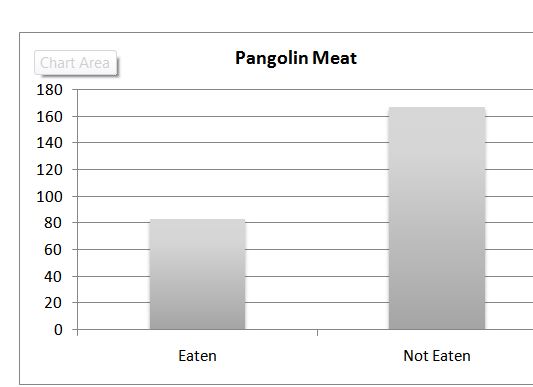
About 33.2% respondents who were aware about the protection status of pangolin had eaten its meat. 66.8% respondents were no eaten meat.
3.2. Old and fresh Burrow
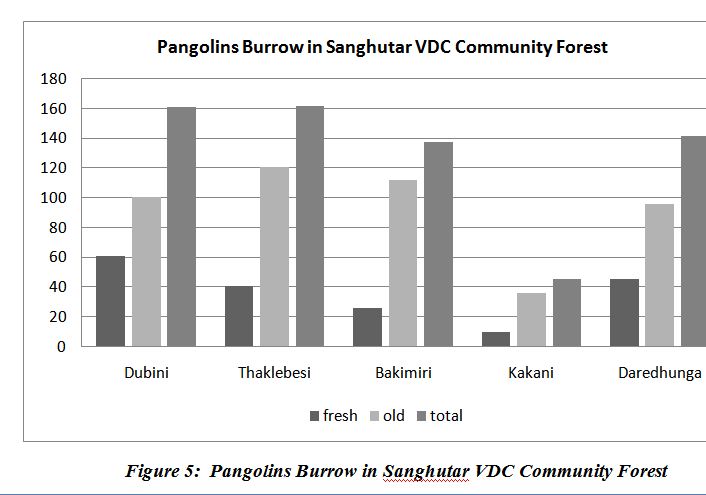
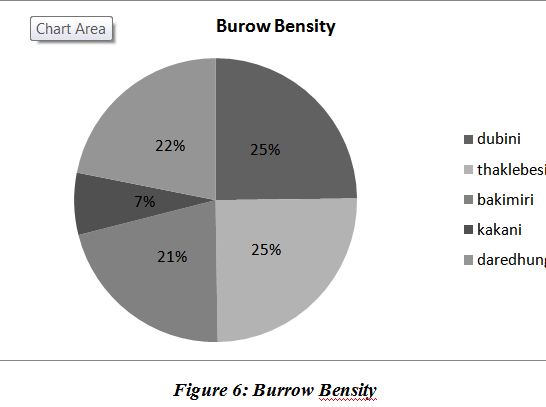
Thaklebesi community forest contain highest number of the burrow. Among them 121 are old and 41 are fresh burrow. But the ratio between fresh and old burrow is more in case of the thaklebesi cf.
Dubinicf contain highest numbers of the fresh burrow that is 61. That contain 101 old burrow. There is higher number of the fresh burrow it is because there is suitable geographical structure, nearer source to water and suitable habitat.
Bakimiricf contain almost 138 burrow among them only 26 is fresh burrow and 112 is old burrow.
Daredhungacfconatins almost 142 burrow among them 46 fresh and 96 old burrow.
Kakanicf contains least number of individual as well as overall burrow. It contains 10 fresh and 36 old burrow. The total number is less may be due to the high altitude, less suitable geographic structure.
That indicate the number of the specie’s population is decreasing on thaklebesi cf. this may be due to the forest degradation habitat fragmentation and climatic factor. And anthropogenic also causes the major role to the population degradation. Unscientific construction and development activities also intervening the species.
3.3. Major conservation threats and Human anthropogenic impact:
Mostly pangolins are found in unprotected area. Almost all the people think that illegal trade is the major threats to the surviving population of pangolins in Sanghutar VDC Ramechhap. The lack of awareness at the local people is boosting up the threats. Open market still exists in some sanghutar VDC Ramechhap. Traders say that it is good medicine of various diseases and encourage villagers to poach. Habitat destruction, unsustainable road development practices fragmentation, slash and burn practices, and weak law enforcement were other major threats.
3.4. Ethno-Biology and Medicinal Use
Sanghutar VDC in Ramechhap People had different perceptions towards the medicinal value of pangolins meat and scale. The meat was used for the treatment of gastro intestinal problem, use as pain killer during pregnancy, cardiac problem, back pain relief, medicine for bone problem where as the scale was used as a symbol of good luck and used to make finger ring to avoid danger, scales were rubbed and used to avoid cure skin diseases, burn wound, also used for teeth problem, and even pneumonia. The scales were kept nearby the “Kokro” (baby basket) to prevent children from different communicable diseases. It was also used to make garland and musical instruments.
3.5. Pangolins in a local market.
Sanghutar VDC in RamechhapPeople speculated that mostly youth are involved in the trade of the pangolins product. The cost of the scale varied from place to place and with the contact of persons. The whole pangolins cost more than its scale. The minimum price for live pangolin is Rs 5000/kg at local hunter. It is chain work and the price gets doubled when it reached to next poachers and so on. The average price of the scale was Rs 15000-20000/kg to Rs 50000-70000/kg and sometimes even more at the borders.
- DISCUSSION
4.1 Major conservation threats and Human anthropogenic impact:
At present habitat loss and poaching are the main threats to most of the animal in Nepal (Jnawali et al., 2011). The problem even gets worst in low educated and weak economic condition villages. Almost all the respondents agreed that human were the prime cause to decline in the population of pangolins. The slash and burn process in the Sanghutar VDC was destroying the habitat of pangolins. People were unknown about the importance of pangolins in their field, so for the sake of money, poachers enforce the villagers to poached it. People caught during the trade were not punished hardly which is boosting up the traders. CITES (2000), Duckworth et al., (2008) and Suwal (2011), discussed that poaching and habitat destruction as important factor for the decline of pangolin population. In Sanghutar VDC.
4.2. Local markets of trade pangolins
Pangolins are protected in Nepal (Baral and Shah, 2008; Jnawali et al., 2011). Inspite this fact, its hunting is increasing. Poachers were inducing local youth of villages for trapping pangolins. The most of the people in village know about the pangolins trade, but do not express their views nor report to the police about the poaching.
Most of the respondents thought that the population of pangolin was decreasing rapidly in their area. Illegal activities of human were major cause for its decline. The major regions behind the poaching of the animal were hunting for meat for medicine, scales for ornaments. Not a single community and a type of occupation people are seen involved in illegal trade. As well as most of the local hoteliers and cattle traders were involved in its trade.. There is no accurate record on the trade of the pangolins in Nepal. The price of the pangolins varies sharply depending upon its size, and species types. Indian pangolins cost more (Rs 25000/kg) than Chinese one (Rs 10000-15000) in some of the place. The minimum price of live pangolin was found to be about Rs 20000/kg increases exponentially to about Rs 70-100 thousands per kg from local villagers to the high rank poachers at the boarders. This price is very less in comparison to the price received by local hunter in Vietnam (more than Rs 10000) (Duckworth et al., 2008) and in China (Rs 15000) (Yue, 2009). The report published in different newspaper revealed that Kavre, Dolakha, Terathum, Panchthar etc. was other vulnerable Sanghutar VDC for the pangolin trade than our study area.
4.3. Ethno-Biology and Medicinal use.
Most of the respondents are not actually aware about the importance of pangolin products in their livelihood. However, people think that meat is used for curing different types of chronic diseases. Cardiac, gastro-intestinal and bone problem patients eat its meat. The scales were rubbed in skin diseases and even the back pain problem. Scales were used in preparing the different types of ornaments and musical instruments. People even make the ring of scale and wear them. CITES (2000) and Duckworth et al., (2008) reported that scales were mostly used in preparing the Chinese medicine The scales of pangolins has even cultural significance in Africa, where it is used in ethno medical purposes (Challender et al., 2012) and has a aphrodisiac properties (Molur, 2008). On the other hand, few people had bad experience after encountering with the pangolins.
A Research In Pangolin's Trade, Importance and It's Cnservation Status In Sanghutar VDC, Ramechhap, Nepal 2016 is done by following :
(Amrit Campus 4th year running, Vice president: Scientific Research Society Nepal)
(Amrit Campus 4th year running, President: Scientific Research Society Nepal)
(Research Supervisor, Associate Professor Tribhuvan University Zoology Department)


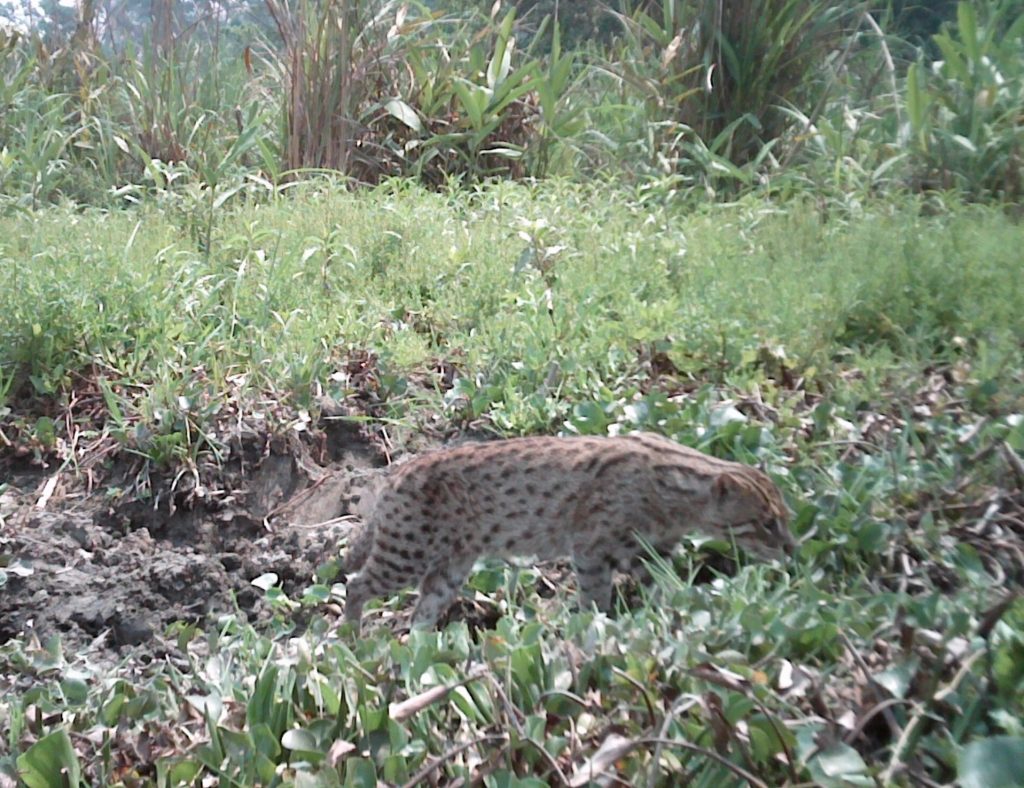
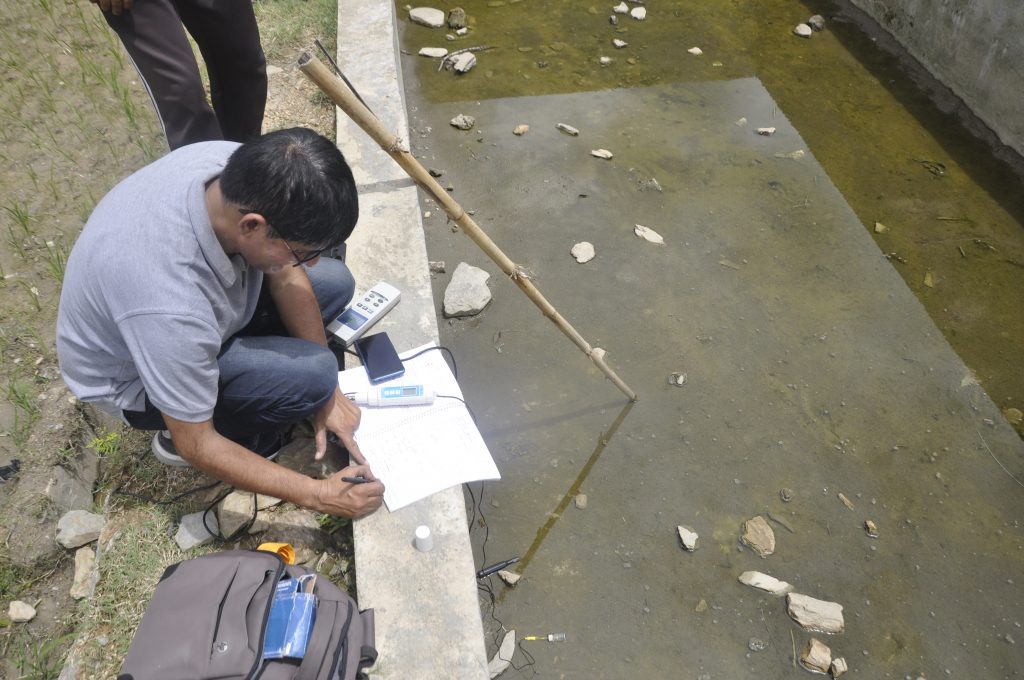

Feedback